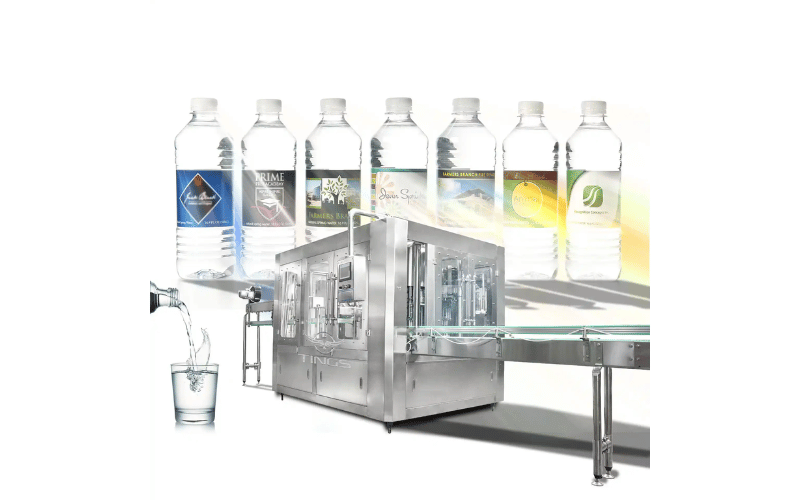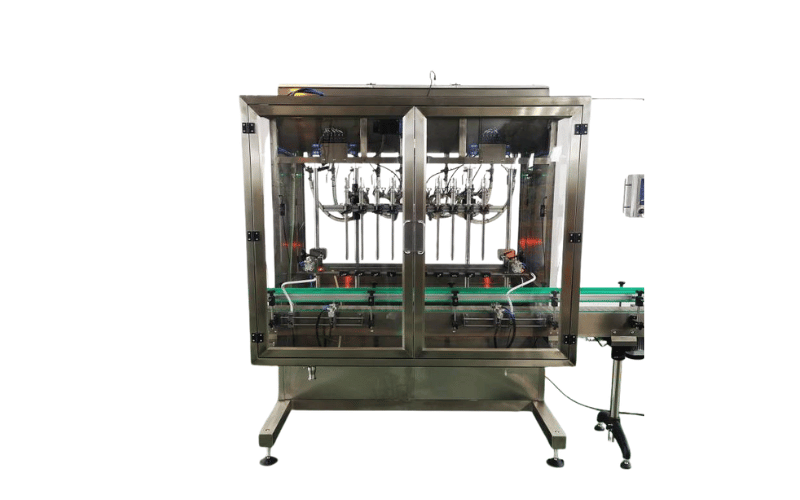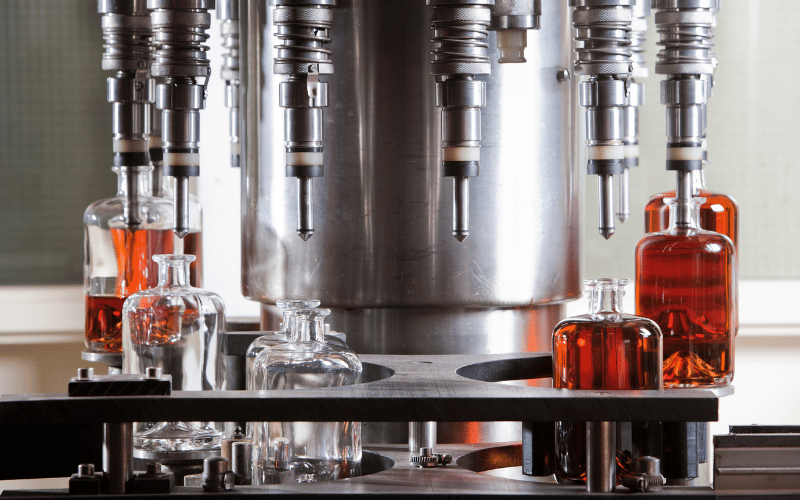Did you know that automated bottling systems can increase production efficiency by up to 50% compared to manual operations? In today’s fast-paced manufacturing world, automation has become a game-changer, helping businesses meet growing demand while maintaining high standards of quality and hygiene.
Automatic water bottle filling systems are at the forefront of this revolution. These systems streamline the bottling process by using advanced technologies to fill, seal, and package water bottles with precision and speed. By eliminating manual intervention, they reduce errors, minimize waste, and ensure consistent results across every production run.
This article examines the key technologies that drive these systems, including programmable logic controllers (PLCs), sensors, and Clean-In-Place (CIP) systems. It also highlights the benefits of automation, including improved accuracy, enhanced hygiene, and reduced labor costs. Whether you’re looking to upgrade your existing setup or invest in a new system, understanding these advancements will help you make informed decisions for your production line.
Table of Contents
ToggleCore Technologies in Automatic Bottle Filling
Automatic bottle filling systems rely on a combination of advanced technologies to ensure efficiency, accuracy, and hygiene. From preparing and handling bottles to selecting the proper filling method, each step plays a critical role in optimizing the bottling process. Let’s dive into the core technologies that make these systems indispensable for modern manufacturing.
Preparation and Handling
Before the filling process begins, bottles must be adequately prepared and aligned to ensure smooth operation. This stage involves several key technologies:
- Bottle Unscramblers and Sorters: These machines take randomly oriented bottles and align them for consistent placement on the production line. For example, a rotary unscrambler gently spins bottles into the correct orientation, ensuring they are ready for the next step.
- Air or Water Rinsing Machines: Hygiene is non-negotiable in the bottling process, especially for food and beverage products. Rinsing machines use high-pressure air or water to clean the inside of each bottle, removing dust or debris before filling. For instance, an air rinser is ideal for lightweight plastic bottles, while a water rinser works well for glass containers.
- Conveyor Systems: Smooth bottle movement is essential for maintaining production speed and avoiding jams. Conveyor systems utilize adjustable belts and guides to transport bottles smoothly between stations, ensuring they remain upright and appropriately spaced throughout the process.
These preparation and handling technologies set the stage for an efficient and hygienic filling operation.
Filling Technologies
The heart of any automatic bottle filling system lies in its filling technology. Different products require different methods, and selecting the right one ensures accuracy and consistency.
Gravity Fillers
Gravity fillers rely on the natural force of gravity to transfer liquid from a reservoir into bottles. They are best suited for thin, non-carbonated liquids, such as water, juice, and cleaning solutions. For example, a gravity filler can efficiently handle high-volume water bottling lines, offering simplicity and cost-effectiveness.
Pressure Fillers
Pressure fillers utilize additional force to push liquid into bottles, making them ideal for thicker liquids such as oils, sauces, or syrups. These machines maintain consistent flow rates even with high-viscosity products, ensuring accurate fills without slowing down production.
Piston Fillers
Piston fillers excel at handling viscous or chunky products, such as jams, creams, or salad dressings. They use a piston-and-cylinder mechanism to measure and dispense precise volumes of product. For instance, a piston filler can easily handle a chunky fruit jam without clogging, delivering consistent fills every time.
Vacuum Fillers
Vacuum fillers are specifically designed for glass bottles and low-viscosity liquids, such as wine, spirits, or specialty oils. These machines create a vacuum inside the bottle, drawing liquid in until it reaches the desired level. This method ensures minimal spillage and is particularly effective for high-value liquids.
Net Weight Fillers
Net weight fillers are the go-to choice for expensive or high-value products where precision is critical. These machines measure the exact weight of liquid dispensed into each bottle, ensuring consistency and reducing product waste. For example, a net weight filler is ideal for bottling premium olive oil, where even slight overfills can result in significant cost increases.
By combining adequate preparation and handling systems with the right filling technology, automatic bottle filling systems deliver unmatched efficiency and precision. Each component works in harmony to meet the unique demands of your product and production line.
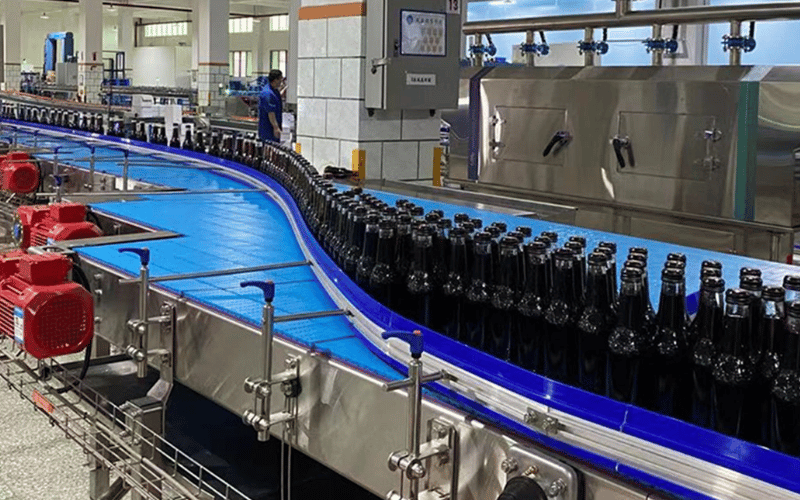
Sealing, Capping, and Integration
Sealing and capping are critical steps in the bottling process, ensuring product integrity and consumer safety. The right capping technology and sealing method can make or break your production line’s efficiency. Additionally, seamless integration with downstream equipment ensures a smooth transition from filling to final packaging. Let’s explore these essential components in detail.
Capping Technologies
Choosing the right capping technology depends on the type of cap and container being used. Each method offers unique advantages tailored to specific applications:
- Screw Cappers: Screw cappers are the workhorses of the bottling industry, designed for threaded caps commonly used on water bottles, soda bottles, and other beverages. These machines apply consistent torque to ensure a secure seal without over-tightening, which could damage the cap or container. For example, a rotary screw capper can handle high-speed production lines, capping hundreds of bottles per minute with precision.
- Snap Cappers: Snap cappers are ideal for press-on caps, such as those used on juice bottles or certain dairy products. These machines apply downward pressure to snap the cap securely onto the container. For instance, a snap capper can efficiently handle lightweight plastic caps, ensuring a tight fit without deforming the bottle.
- R.O.P.P. Cappers: Roll-On Pilfer-Proof (R.O.P.P.) cappers are designed for metal caps with unique threading, often used on wine bottles, spirits, and pharmaceutical products. These machines roll threads directly onto the cap as it is applied, creating a tamper-evident seal. An R.O.P.P. capper is perfect for ensuring both security and a professional finish on high-value products.
Sealing Methods
Sealing methods play a vital role in preserving product freshness and preventing contamination. The choice of method depends on the packaging material and product requirements:
- Induction Sealing: Induction sealing creates hermetic seals by using electromagnetic energy to heat a foil liner inside the cap, resulting in a secure seal. This method is widely used for food, beverages, and pharmaceuticals, as it ensures tamper evidence and extends shelf life. For example, an induction sealer can quickly and efficiently seal plastic bottles of juice, providing a leak-proof and airtight seal.
- Heat Sealing: Heat sealing is commonly used for specific packaging needs, such as sealing pouches, blister packs, or certain types of plastic containers. This method uses heat and pressure to bond materials together, creating a secure seal. For instance, a heat sealer is ideal for single-serve yogurt cups, ensuring freshness and preventing leaks.
Integration with Downstream Equipment
A well-designed bottling line doesn’t stop at filling and capping. Integration with downstream equipment ensures a seamless transition to labeling, coding, and packaging:
- Labeling Machines: Labeling machines apply product labels with precision, ensuring they are aligned and wrinkle-free. For example, a wrap-around labeler can handle cylindrical bottles, applying labels quickly and accurately.
- Coding Systems: Coding systems add essential information, such as batch numbers, expiration dates, or barcodes, to bottles or labels. Laser coders and inkjet printers are popular options, offering high-speed and reliable marking.
- Case Packing Robots: Case packing robots automate the final stage of packaging, placing bottles into cases or cartons for shipping and distribution. These robots can handle various configurations, such as 6-packs or 12-packs, ensuring efficiency and consistency.
By selecting the proper capping and sealing technologies and integrating them with downstream equipment, you can create a streamlined bottling line that meets your production goals while maintaining product quality and safety. Each component works together to ensure a smooth, efficient, and reliable operation.
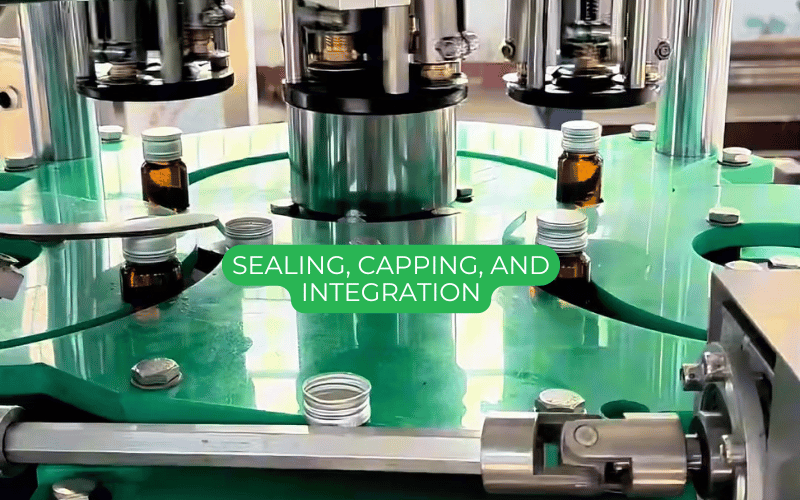
Benefits of Automatic Bottle Filling Systems
Automatic bottle filling systems have revolutionized the bottling process, offering a range of benefits that enhance productivity, accuracy, and safety. By combining speed, precision, and adaptability, these systems meet the demands of modern manufacturing while upholding high standards of quality. Let’s explore the key advantages in detail.
Speed and Efficiency
Speed and efficiency are at the core of automatic bottle filling systems, making them indispensable for high-volume production lines.
- High-Speed Filling Lines: Automatic systems can fill hundreds or even thousands of bottles per hour, significantly increasing throughput compared to manual operations. For example, a high-speed rotary filler can handle up to 1,200 bottles per minute, ensuring you meet tight production deadlines without compromising quality.
- Simultaneous Filling of Multiple Bottles: Multi-head filling machines enable you to fill multiple bottles simultaneously, saving valuable time. A 12-head gravity filler, for instance, can fill a dozen bottles simultaneously, making it ideal for large-scale operations.
By optimizing speed and efficiency, these systems help manufacturers meet growing demand while reducing labor costs.
Accuracy and Consistency
Precision is crucial in bottling, particularly for products where overfills or underfills can result in waste or customer dissatisfaction. Automatic systems excel in delivering consistent results.
- Eliminates Human Error: Automated controls ensure precise product measurements, removing the variability associated with manual filling. For instance, a net weight filler can dispense exact amounts of high-value liquids, such as essential oils, minimizing waste and maximizing profitability.
- Ensures Uniformity Across All Bottles: Advanced sensors and programmable settings maintain consistent fill levels, ensuring every bottle looks identical on the shelf. This uniformity is essential for transparent containers, where visual consistency has a direct impact on consumer perception.
With their focus on accuracy, automatic systems enhance product quality and reduce costly errors.
Hygiene and Safety
Hygiene and safety are non-negotiable in industries like food, beverage, and pharmaceuticals. Automatic bottle filling systems are designed to meet stringent standards for cleanliness.
- Stainless Steel Materials: Most systems utilize stainless steel components, which resist corrosion and are easily sanitized. This material choice prevents contamination and ensures compliance with industry regulations.
- Automated Cleaning Cycles (CIP/SIP): Clean-In-Place (CIP) and Sterilize-In-Place (SIP) systems automate the cleaning process, eliminating the need for manual disassembly. For example, a CIP system can flush the machine with cleaning solutions between production runs, ensuring food and beverage safety without interrupting operations.
These features make automatic systems a reliable choice for maintaining hygiene and protecting consumer health.
Flexibility and Scalability
Modern bottling lines must adapt to changing production needs, and automatic systems offer the flexibility to handle a wide range of products and packaging.
- Handles Various Bottle Sizes and Liquid Viscosities: Automatic fillers can accommodate different bottle shapes, sizes, and materials, as well as liquids with varying viscosities. For instance, a piston filler can handle both thin liquids, such as water, and thick products, like honey, making it versatile for a wide range of applications.
- Expandable with Additional Filler Heads: As production scales, you can expand your system by adding more filler heads, increasing capacity without needing to replace the entire machine. A 6-head filler, for example, can be upgraded to a 12-head system to meet higher demand.
This adaptability ensures that your bottling line grows in tandem with your business, providing long-term value and efficiency.
By delivering speed, precision, hygiene, and scalability, automatic bottle filling systems empower manufacturers to optimize their operations and meet the demands of a competitive market. Each feature works together to create a seamless, efficient, and reliable bottling process.
Control and Monitoring Technologies
Control and monitoring technologies form the backbone of modern filling machines, ensuring precision, efficiency, and reliability throughout the bottling process. These systems work together to manage operations, detect issues, and provide real-time feedback, empowering operators to maintain peak performance. Let’s explore the key technologies that make this possible.
Programmable Logic Controllers (PLCs)
PLCs act as the brain of the filling system, orchestrating every operation with precision and synchronization.
- Managing Operations and Synchronization: A PLC controls the timing and sequence of each step in the filling process, from bottle positioning to liquid dispensing and capping. For example, it ensures that the conveyor system places bottles in position just as the fill nozzles activate, preventing delays or misalignment.
- Customizable Programming: Operators can program PLCs to handle different products, bottle sizes, and production speeds. For instance, switching from a 500ml water bottle to a 1L juice bottle is as simple as selecting a pre-programmed setting, which saves time and reduces errors during product changeovers.
By centralizing control, PLCs ensure that every component of the system works in harmony, maximizing efficiency and accuracy.
Sensor Technology
Sensors play a critical role in maintaining accuracy and quality throughout the bottling process.
- Level Sensors for Accurate Liquid Amounts: Level sensors monitor the liquid in the reservoir and in each bottle, ensuring consistent fill levels. For example, ultrasonic sensors can detect even slight variations in liquid height, triggering adjustments to maintain precision.
- Vision Systems for Cap Placement and Label Inspection: Vision systems use cameras to inspect bottles for proper cap placement and label alignment. If a cap is missing or a label is misaligned, the system can reject the bottle before it reaches the next stage. For instance, a vision system can detect a crooked label on a soda bottle and alert the operator to adjust the labeling machine.
These sensors act as the eyes and ears of the system, catching issues before they escalate and ensuring consistent product quality.
Human Machine Interface (HMI)
The HMI serves as the bridge between the operator and the machine, providing real-time data and intuitive controls.
- Real-Time Data Monitoring and Fault Diagnostics: The HMI displays key performance metrics, such as production speed, fill accuracy, and system status. If a fault occurs, the interface provides detailed diagnostics, helping operators identify and resolve the issue quickly. For example, if a nozzle malfunctions, the HMI might display an error code and suggest corrective actions.
- User-Friendly Control Panels for Easy Operation: Modern HMIs feature touchscreens with intuitive menus, allowing operators to easily adjust settings, monitor performance, and troubleshoot problems. For instance, an operator can use the HMI to increase the fill speed during peak production hours or switch to a different product line with just a few taps.
The HMI empowers operators to take control of the system, ensuring smooth and efficient operation at all times.
By combining the intelligence of PLCs, the precision of sensors, and the accessibility of HMIs, control and monitoring technologies create a seamless and reliable bottling process. These tools not only enhance performance but also give operators the confidence to manage complex systems with ease.
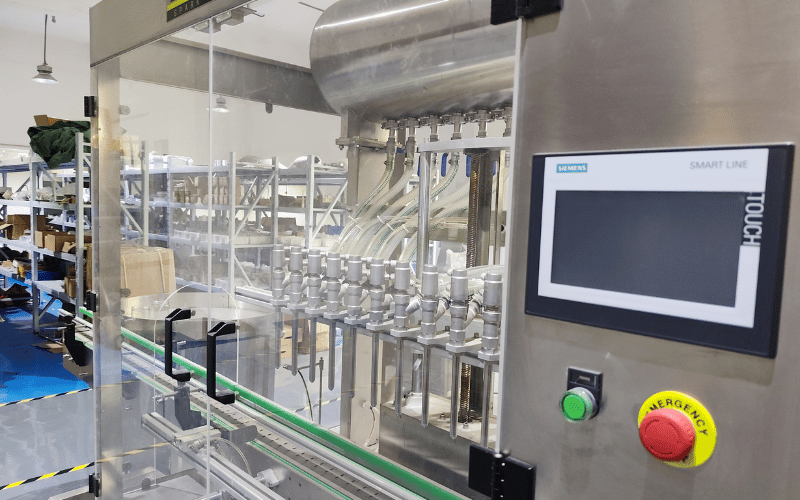
Choosing the Right System for Your Needs
Selecting the right filling system is a critical decision that directly impacts your production efficiency, product quality, and overall operational success. To make the best choice, you need to evaluate key factors and match the technology to your specific application. Let’s break this process down into actionable steps.
Factors to Consider
Before diving into specific technologies, take a close look at the unique requirements of your product and production line.
- Liquid Viscosity: The thickness of your liquid determines which filling technology will work best for you. For example, thin, free-flowing liquids, such as water or juice, are ideal for gravity fillers, while thicker products, like honey or lotion, require piston fillers to handle their viscosity.
- Container Type: The shape, size, and material of your containers also play a role. Glass bottles may require vacuum fillers for precision, while lightweight plastic bottles are better suited for gravity or overflow fillers.
- Production Speed: High-speed production lines require systems that can maintain accuracy while keeping up with the pace. Multi-head fillers, for instance, can handle large volumes efficiently, making them ideal for high-demand operations.
- Hygiene Requirements: Industries such as food, beverage, and pharmaceuticals must meet stringent hygiene standards. Look for systems with stainless steel components and Clean-In-Place (CIP) capabilities to ensure compliance and prevent contamination.
- Budget Constraints: While advanced systems offer more features, they also come with higher costs. Evaluate your budget and prioritize the features that align with your production goals. For example, a small-scale operation might begin with a gravity filler and upgrade to a more advanced system as production volume increases.
By carefully considering these factors, you can narrow down your options and focus on the technologies that best meet your needs.
Matching Technology to Applications
Once you’ve identified your requirements, it’s time to match the right filling technology to your specific application.
- Gravity Fillers for Water and Juices: Gravity fillers are the preferred choice for thin, non-carbonated liquids, such as water, juices, and cleaning solutions. Their simplicity and cost-effectiveness make them ideal for high-volume production lines. For example, a 12-head gravity filler can efficiently handle thousands of water bottles per hour with consistent accuracy.
- Piston Fillers for Thick Products Like Creams and Pastes: Piston fillers excel at handling viscous or chunky products, such as peanut butter, hand creams, or pasta sauces. Their piston-and-cylinder mechanism ensures precise volumetric dosing, even for products with particulates. For instance, a piston filler can dispense a consistent amount of chunky salsa without clogging or compromising accuracy.
- Net Weight Fillers for High-Value Liquids: Net weight fillers are ideal for premium or high-value products, such as essential oils, premium spirits, or pharmaceutical liquids. These systems measure the exact weight of the liquid in each container, ensuring precision and minimizing waste. For example, a net weight filler can accurately dispense high-end olive oil, protecting your margins while maintaining quality.
By aligning your product characteristics and production goals with the right filling technology, you can create a bottling line that delivers efficiency, accuracy, and reliability. Each system has its strengths, and understanding how they fit into your operation ensures you make a choice that supports both your current needs and future growth.
Future Trends in Bottle Filling Technology
The bottle filling industry is evolving rapidly, driven by technological advancements and the increasing demand for sustainable, efficient, and flexible solutions. Staying ahead of these trends can help manufacturers optimize their operations and remain competitive. Let’s explore the key innovations shaping the future of bottle filling technology.
Smart Automation and AI
Automation is no longer just about speed—it’s about intelligence. Smart systems powered by AI and IoT are transforming how filling machines operate and maintain themselves.
- Predictive Maintenance Using AI: AI-driven systems can analyze machine performance data to predict potential issues before they cause downtime. For example, an AI algorithm might detect subtle changes in nozzle performance, alerting operators to clean or replace the nozzle before it affects production. This proactive approach reduces unplanned downtime and extends the lifespan of critical components.
- IoT Sensors for Enhanced Data Collection and Real-Time Adjustments: IoT-enabled sensors collect real-time data on variables like fill levels, flow rates, and temperature. This data allows the system to make instant adjustments, ensuring consistent performance. For instance, if a sensor detects a slight variation in liquid viscosity due to temperature changes, the system can automatically recalibrate fill times to maintain accuracy.
These smart technologies not only improve efficiency but also give operators greater control and insight into their production lines.
Sustainability and Efficiency
As environmental concerns grow, manufacturers are prioritizing sustainability without compromising efficiency. Future filling systems are designed to meet these dual goals.
- Energy-Efficient Designs to Reduce Operational Costs: Newer machines incorporate energy-saving features, such as variable frequency drives (VFDs) and optimized motor designs. For example, a filling system equipped with VFDs can adjust motor speed in response to production demand, thereby reducing energy consumption during slower cycles.
- Systems Designed for Lightweight and Recycled Packaging: With the rise of eco-friendly packaging, filling machines are adapting to handle lightweight and recycled materials. For instance, advanced conveyor systems with gentle handling capabilities ensure that lightweight plastic bottles don’t deform or tip over during the filling process.
By focusing on sustainability, these systems help manufacturers reduce their environmental footprint while maintaining high production standards.
Enhanced Flexibility
Flexibility is becoming a cornerstone of modern filling systems, enabling manufacturers to adapt to changing market demands and product variations quickly.
- Quick Changeover Systems to Minimize Downtime: Quick changeover systems enable operators to switch between different bottle sizes or products in minutes rather than hours. For example, a machine with tool-free adjustments and pre-programmed settings can transition from filling 500ml water bottles to 1L juice bottles with minimal effort.
- Modular Designs for Scalability and Adaptability: Modular systems allow manufacturers to expand or reconfigure their filling lines as production needs evolve. For instance, a 6-head filler can be upgraded to a 12-head system by adding additional modules, providing a cost-effective way to scale operations.
These flexible designs ensure that filling systems remain future-proof, capable of adapting to new challenges and opportunities.
By embracing smart automation, sustainability, and flexibility, the future of bottle filling technology promises to deliver greater efficiency, precision, and adaptability. These trends not only address current industry challenges but also pave the way for innovative solutions that will shape the bottling industry for years to come.
FAQs: Common Questions About Automatic Bottle Filling
Q: How long does it take to install an automatic bottle-filling system?
A: Installation time depends on the complexity of the system and the size of your production line. On average, it takes 1 to 2 weeks to install and test a standard filling system. Larger, more complex setups with multiple components, such as cappers and labelers, may require up to 4 weeks. Proper planning and preparation, such as ensuring utilities like power and compressed air are in place, can help expedite the process.
Q: What is the difference between volumetric and overflow filling technologies?
A: Volumetric filling measures and dispenses a precise volume of liquid into each container, making it ideal for products where accuracy is critical, such as pharmaceuticals or high-value liquids. Overflow filling, on the other hand, fills containers to a consistent visual level, which is especially important for clear bottles where a uniform appearance is crucial, such as in beverages. While volumetric filling prioritizes precision, overflow filling focuses on aesthetic consistency.
Q: Can automatic filling machines handle both thick and thin liquids?
A: Yes, many automatic filling machines are designed to handle a wide range of liquid viscosities. For thin, free-flowing liquids like water or juice, gravity or overflow fillers are most effective. For thicker products like honey, creams, or sauces, piston fillers or pressure fillers provide the necessary force to ensure accurate and consistent fills. Some advanced systems even allow operators to switch between different filling technologies to accommodate various products.
Q: What maintenance is required for high-speed bottle filling equipment?
A: High-speed filling equipment requires regular maintenance to ensure optimal performance. Key tasks include cleaning nozzles and reservoirs to prevent clogs, inspecting seals and gaskets for wear and tear, and lubricating moving parts to reduce friction. You should also schedule periodic calibration checks to maintain fill accuracy and replace worn components, such as belts or sensors, as needed. Following the manufacturer’s maintenance schedule helps minimize downtime and extend the machine’s lifespan.
Q: How do automated systems ensure accurate fill levels?
A: Automated systems use advanced technologies like flow meters, level sensors, and programmable logic controllers (PLCs) to ensure accurate fill levels. For example, flow meters measure the exact volume of liquid dispensed, while level sensors monitor the liquid height in each container. PLCs synchronize these components, making real-time adjustments to maintain precision even if variables like liquid viscosity or temperature change during production.
Q: What safety features are standard on modern bottle filling lines?
A: Modern bottle filling lines include several safety features to protect operators and ensure smooth operation. Emergency stop buttons enable operators to halt the system immediately in the event of an issue. Safety guards and interlocks prevent access to moving parts while the machine is running. Additionally, automated fault detection systems alert operators to problems such as misaligned bottles or nozzle blockages, thereby reducing the risk of accidents and ensuring consistent performance.
Conclusion: The Future of Bottling is Automated
Automatic water bottle filling systems deliver unmatched speed, accuracy, and hygiene, making them essential for efficient production. Automation drives modern manufacturing by streamlining operations, reducing errors, and ensuring high-quality standards are maintained. Businesses that invest in advanced technologies position themselves for long-term success, staying competitive in an ever-evolving industry.

